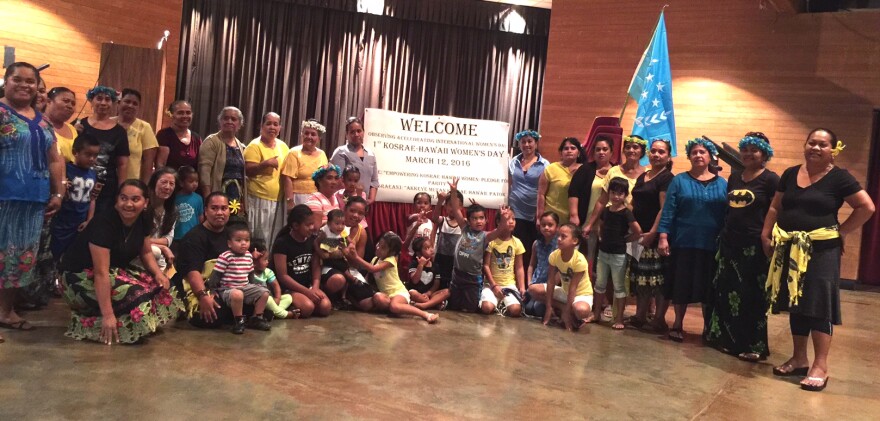Twelve groups of dancers from across Micronesia, craft demonstrations, a little marketplace, a Chamorro food truck, you will get an immersion in Micronesian culture tomorrow, 10-4, at the Honolulu Museum of Art School. It's all part of the Celebrate Micronesia! Festival and HPR’s Noe Tanigawa discovered all that is just the tip of the iceberg.
The Carrying Culture Workshop for Elementary Education gives teachers tools and strategies based on Micronesian culture. It sold out in one day. Mary Therese Perez Hattori, Outreach Director for Center for Pacific island Studies, is Chamorro from Guam. She helped develop the curriculum.

“Teachers will ask is there a universal word in Micronesia that I could use so my students will all calm down?”
The answer is no. In the Federated States alone, there’s Chuukese, English, Kapingamarangi, Kosraean, Mokilese, Morlockese, Namonuito, Nguluan, Nukuoro, Paafang, Pingelapese, Pohnpeian, Puluwatese, Satawalese, Ulithian and more. These are not dialects. They’re distinct languages. The diversity in Micronesia is amazing.
“The research shows students will succeed in American schools if they’re allowed to retain their identity and if their cultural values are respected in the classroom.”
Differences in culture may not even be perceptible to the dominant culture.
“The culture of American schools is very individualistic, but many societies, most of the world’s societies in fact, are communal. So what skills can you gain in school to help your community?”
Hattori says U.S. youth are allowed to be kids, to be simply students or athletes.

“But for many Micronesians that’s never your only role in life. You may be a student, but you have family responsibilities, you might have church responsibilities, and these are all wonderful things that we value in our community. So it may mean you’re a little late because you’re going to drop somebody else off at another school on your way to school. A teacher not understanding our culture will perceive that as, you don’t care about school, you’re irresponsible because you’re not coming to school on time.”
Little misunderstandings mount.
“We’re all a minority here. Hawai‘i is touted as a melting pot but there isn’t that racial harmony here. So there is a degree of racial prejudice, discrimination, that everyone has to deal with when they move here.”
Hattori says a little more education for the dominant culture would help. For example, as fellow Pacific Islanders, how many here can locate Micronesia on a map? And Hattori says the way we use the word Micronesia is problematic, often in reference only to people from the Federated States of Micronesia. Micronesia is a region, not just the Federated States. Micronesia includes about 2100 islands, in a thousand square mile space east of Hawai‘i, by the way.
Hattori says, when you meet someone from Micronesia, ask what country they're from, because differences can be vast. Then ask what island they're from and you'll begin to get a sense of this person's experience.
Last weekend, the first Kosrae-Hawai‘i Women‘s Day unfolded at Mc Coy pavilion. UH law student Sweetyona Tulensru coordinated this first time meet up of Kosraean women to survey needs and publicize services available to the community. She did it as a part of a class on organizing.
Asked what distinguishes Kosraeans among Micronesians, Sweetyona said, “The main thing Kosraeans are known for is how religious they are. Back home, there’s not supposed to work or anything going on Sundays. Everyone goes to church, and services are almost all day, from 9 to 5. Part of that is Kosraeans are really into singing.” I was at Micronesia Mart one day looking through CD's and the clerk said, Kosraeans are the best singers!
Sweetyona said Kosraean services on O‘ahu take place every Sunday at Kaimuk? High School starting at 10:30.
Children sped past us, a table of food was coming together, and everyone proudly wore the color of their municipality in Kosrae. Kenye Joel was wearing yellow and she explained, her town, Melem, is the best surf spot on the island.
Meltina Kibby, another Celebrate Micronesia coordinator, says this year, a Micronesian women’s summit will follow on Sunday.
“We can be of great help to the state of Hawai‘I, and that’s what we’ve been out fighting trying to do. I’m not here to take, I’m here to help!”
Celebrate Micronesia! 10-4 tomorrow at the Honolulu Museum School.






